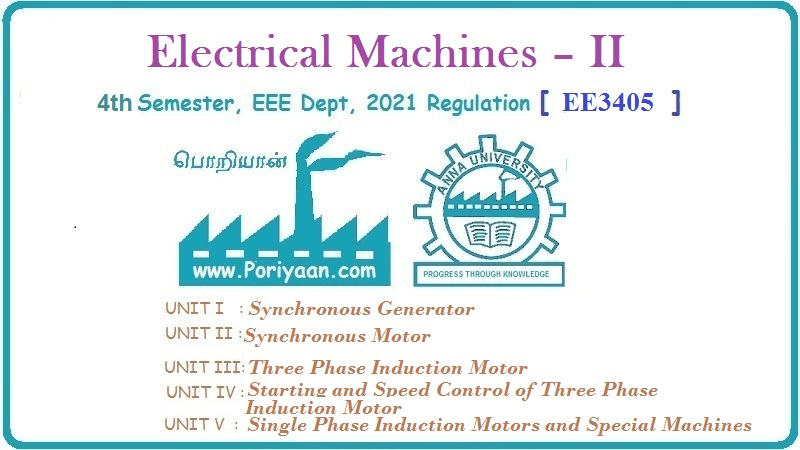Electrical Machines II: UNIT II: Synchronous Motor
Operation of Synchronous Motor at Constant Load Variable Excitation
At start, consider normal behaviour of the synchronous motor, where excitation is adjusted to get Eb = V i.e. induced e.m.f. is equal to applied voltage. Such an excitation is called Normal Excitation of the motor.
Operation of Synchronous Motor at Constant Load Variable
Excitation
In
the last article we have seen that when load changes, for constant excitation,
current drawn by the motor increases. But if excitation i.e. field current is
changed keeping load constant, the synchronous motor reacts by changing its
power factor of operation. This is most interesting feature of synchronous
motor. Let us see the details of such operation.
Consider
a synchronous motor operating at a certain load. The corresponding load angle
is δ .
At
start, consider normal behaviour of the synchronous motor, where excitation is
adjusted to get Eb = V i.e. induced e.m.f. is equal to applied voltage. Such an
excitation is called Normal Excitation of the motor. Motor is drawing
certain current Ia from the supply and power input to the motor is say Pin.
The power factor of the motor is lagging in nature as shown in the Fig. 4.10.1
(a).

Now
when excitation is changed, Eb changes but there is hardly any
change in the losses of the motor. So the power input also remains same for
constant load demanding same power output.
Now Pin = √3 VL IL
cosϕ = 3 (Vph Iaph cos ϕ)
Most
of the times, the voltage applied to the motor is constant. Hence for constant
power input as Vph is constant, 'Iaph cos ϕ remains
constant.
Key Point So for this
entire operation of variable excitation it is necessary to remember that the
cosine component of armature current, 'Ia cos ϕ' remains constant.
So
motor adjusts its cos ϕ i.e. p.f. nature and value so that Ia cos 0 remains
constant when excitation of the motor is changed keeping load constant. This is
the reason why synchronous motor reacts by changing its power factor to
variable excitation conditions.
1. Under Excitation
When
the excitation is adjusted in such a way that the magnitude of induced e.m.f.
is less than the applied voltage (Eb < V) the excitation is
called Under excitation.
Due
to this, ER increases in magnitude. This means for constant Zs,
current drawn by the motor increases. But ER phase shifts in such a
way that, phasor Ia also shifts (as ER Λ Ia = θ)
to keep Ia cos ϕ component constant. This is shown in the Fig.
4.10.1 (b). So in under excited condition, current drawn by the motor
increases. The p.f. cos ϕ decreases and becomes more and more lagging in
nature.
2. Over Excitation
The
excitation to the field winding for which the induced e.m.f. becomes greater
than applied voltage (Eb > V), is called over excitation.
Due
to increased magnitude of Eb' ER also increases in
magnitude. But the phase of ER also changes. Now ER Λ Ia
= θ is constant, hence Ia also changes its phase. So θ changes. The
Ia increases to keep Ia cos constant as shown in Fig.
4.10.1 (c). The phase of ER changes so that Ia becomes
leading with respect to Vph in over excited condition. So power
factor of the motor becomes leading in nature. So overexcited synchronous motor
works on leading power factor. So power factor decreases as over excitation
increases but it becomes more and more leading in nature.
3. Critical Excitation
When
the excitation is changed, the power factor changes. The excitation for which
the power factor of the motor is unity (cos ϕ = 1) is called critical
excitation. Then Iaph is in phase with Vph. Now Ia
cos ϕ must be constant, cos ϕ = 1 is at its maximum hence motor has to draw
minimum current from supply for unity power factor condition.
So
for critical excitation, cos ϕ = 1 and current drawn by the motor is minimum
compared to current drawn by the motor for various excitation conditions. This
is shown in the Fig. 4.10.1 (d).

Review Question
1. Explain the operation of synchronous motor at constant load
variable excitation.
AU : May-09, 10, 12, 13, 14, 16,18, Dec.-07, 11, 16, Marks 8
Electrical Machines II: UNIT II: Synchronous Motor : Tag: Engineering Electrical Machines - II : - Operation of Synchronous Motor at Constant Load Variable Excitation
Related Topics
Related Subjects
Electrical Machines II
EE3405 Machine 2 EM 2 4th Semester EEE Dept | 2021 Regulation | 4th Semester EEE Dept 2021 Regulation
